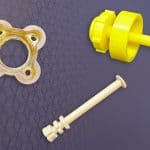
Modern engineering has transformed through advances in aerospace polymers. Research shows 79,789 documents on additive manufacturing published as of February 2025. The United States guides this research race with 19,563 documents. China follows with 13,739 and Germany with 7,856. The field’s rapid growth shows clearly in the numbers – 14,299 documents came out in 2024 alone.
Fiber-reinforced polymers (FRPs) stand out as next-generation composite materials for aerospace applications. These innovative materials create an impressive strength-to-weight ratio by combining the lightweight properties of polymers with embedded fiber’s strength. Recent advances in polymer-based skins for morphing wings now use shape memory polymers (SMPs) and electroactive polymers (EAPs). These developments have become a revolutionary force in adaptive aircraft technologies. Each material requires careful testing of tensile strength, elasticity, and fatigue resistance to perform optimally in aerospace parts.
In this article, I’ll detail these surprising material properties and their role in reshaping aerospace engineering. We’ll also explore how environmentally responsible choices influence the industry through natural fiber and agro-waste reinforcements in aerospace polymers.
Key Takeaways
| Section | Key Takeaways |
| Introduction | Aerospace polymer research is accelerating, with over 14,000 publications in 2024 alone. Fiber-reinforced polymers (FRPs) and adaptive materials like SMPs and EAPs are central to current advancements. |
| Emerging Classes of Aerospace Polymers | Thermosets dominate aerospace prepregs (>95%) despite thermoplastics offering better impact and chemical resistance. High-temp processing favors thermoplastics for efficiency. |
| Role of FRPs in Lightweight Design | FRPs are integral to lightweight aircraft (e.g., Boeing 787, Airbus A350 use >50% composites). Continuous fibers provide superior mechanical strength; autoclave curing ensures performance. |
| Biopolymer Integration | Biodegradable polymers like PLA and mycelium packaging are gaining interest for sustainability. 3D printing enables lightweight, eco-friendly component design. |
| Unexpected Mechanical Behaviors | Polymers display viscoelastic behavior and thermal expansion anomalies (ZTE, NTE), offering dimensional stability under extreme aerospace conditions. |
| Fatigue Resistance in Recycled Polymers | Recycled aerospace polymers exhibit high fatigue resistance and stable glass transition behavior, making them viable for non-critical components. |
| Application-Specific Performance | – Jet Engines: Thermoplastics like PEI and PEEK reduce weight and maintain thermal/pressure resistance. – Morphing Wings: SMPs enable adaptive aero surfaces by changing shape at elevated temperatures. – Cabins: Material choices balance fire safety with weight; PEI and flame-retardant polyamides are typical. |
| Precision Machining Compatibility | Advanced polymers require post-cure machining for tight tolerances. Innovations in resins and layup technologies expand part complexity and performance. |
| Sustainability and Scalability Challenges | – Moisture Sensitivity: Natural fibers absorb water, reducing structural integrity; chemical and physical treatments offer mitigation. – Recyclability: PI waste is more manageable than PC waste; mixed composition and contamination hinder reuse. – Material Uniformity: LFAM and additive methods face challenges in thermal control and consistency during scale-up. |
| Conclusion | Aerospace polymers now define modern aircraft design, offering performance and adaptability. However, environmental and scalability challenges remain critical to future development. |
Emerging Classes of Aerospace Polymers
The aerospace engineering world keeps seeing breakthroughs in polymer materials that meet tough new requirements. These changes are altering the map of how engineers design and build aircraft.
Thermoplastics vs Thermosets in Aerospace Use
The main difference between thermoplastic and thermoset composites comes from how their molecules are structured and processed. Thermoset composites create permanent cross-links when they cure and you can’t melt them again. Thermoplastics have straight polymer chains that let you melt and reshape them many times. Thermoset materials still rule aerospace applications. In fact, they make up more than 95% of aerospace prepregs.
Thermoplastics bring some great benefits to the table. They resist impact better, handle damage well, and stand up to chemicals. Their processing works differently too. Thermoplastics need higher temperatures (300-400°C) but process faster with no cure cycle. Thermosets work at lower temperatures (120-180°C) but take longer because they need cure cycles.
Role of Fiber-Reinforced Polymers in Lightweight Design
Fiber-reinforced polymer (FRP) composite structures are now crucial in aerospace engineering because they’re incredibly strong for their weight. Boeing 787’s structure is 50% composites, and Airbus A350 uses 52% – making these the most advanced passenger planes in the world. These lightweight materials cut down aircraft weight significantly, which saves fuel and money.
Engineers prefer continuous fiber-reinforced composites over staple fiber versions in aerospace because they’re stronger mechanically. The quality of manufacturing determines how well these materials perform in real life. Autoclave technology remains the most reliable curing method, though it uses lots of energy.
Biopolymer Integration in Aerospace Components
Biodegradable polymers offer an environmentally responsible option instead of regular materials in aerospace. Unlike synthetic polymers that sit in landfills forever, biodegradable ones break down into safe byproducts, which helps solve major environmental issues. When combined with 3D printing, these materials create complex, lightweight parts while using less material.
Aerospace companies are finding new ways to use biopolymers in their designs and manufacturing. Materials like polylactic acid (PLA) work well to replace oil-based products such as bottles and other items used on planes. Mycelium packaging has caught everyone’s attention because it’s both cheap and biodegradable.
These new polymer types will play a bigger role in future aerospace design as the need for lightweight, high-performance materials keeps growing.
Unexpected Mechanical Behaviors in New Polymer Systems
Over the last several years, polymer researchers have discovered surprising mechanical behaviors that challenge traditional material science assumptions, particularly in extreme aerospace environments.
Viscoelasticity Under High-Altitude Conditions
Aerospace polymers exhibit both viscous and elastic characteristics during deformation, which represents their fundamental viscoelastic property. These materials display time-dependent strain responses that change significantly with altitude conditions. Polymer chains experience restricted movement due to extreme temperature variations at higher altitudes. The complex dynamic modulus (G = G′ + iG″) effectively shows the relationship between oscillating stress and strain in viscoelastic aerospace materials. Components that experience quick load changes during flight depend critically on this property.
Thermal Expansion Anomalies in Composite Blends
Aerospace polymer composites exhibit unexpected thermal expansion behaviors that challenge conventional wisdom:
- Zero Thermal Expansion (ZTE) can be achieved under specific conditions, making these materials dimensionally stable across temperature ranges
- Coefficient of thermal expansion (CTE) values range from 30-300 ppm K⁻¹ for soft molecular materials, reaching up to 10³ ppm K⁻¹ for supramolecular networks
- Negative thermal expansion (NTE) materials can reach approximately -10³ ppm K⁻¹ through conformational changes in pure polymers
These unusual properties create new opportunities to design aerospace components with precise dimensional stability across extreme temperature gradients.
Fatigue Resistance in Recycled Polymer Matrices
Recycled aerospace-grade polymers show remarkable fatigue resistance characteristics. Impact penetration tests show that recycled composites absorb nearly 25% of energy until reaching maximum force and over 50% during puncture deflection. Glass transition temperature (Tg) measurements through DSC and DMA reveal values of 54.7°C and 51.1±1.6°C respectively, while fiber-reinforced composites show higher Tg values. Storage modulus tests confirm that these materials retain 95% of their maximum value at room temperature and maintain 80% near Tg. Such impressive performance makes recycled polymers viable options for non-critical aerospace applications.
Application-Specific Performance in Aerospace Parts
Advanced polymers are revolutionizing performance capabilities in aerospace components. Each application needs specific material solutions to address its unique challenges.
Polymer Use in Jet Engine Components
Modern jet engine design has changed dramatically thanks to high-performance thermoplastics that replace metal components. Thermoplastic polyimides (TPI), especially polyetherimide (PEI), work great in gas exchange components because they resist temperatures above 150°C and weigh less than aluminum.
Epoxy-based polymers play a specific role in jet engine fronts where abradability matters more than weight reduction. These materials wear down against moving parts and improve aerodynamic performance by keeping components close together. CFM’s LEAP engine shows how effective polymer integration can be. It weighs 450kg less than its 2,500kg predecessor by using PEEK and carbon/epoxy composites, which cuts fuel consumption by about 30%.
Morphing Wing Skins Using Shape Memory Polymers
Shape memory polymers (SMPs) are changing how we think about adaptive wing technology. These smart materials stay stiff like plastic in their glassy state to handle aerodynamic loads. Heat them above their glass transition temperature and they become soft and rubbery. This makes them perfect for morphing wing applications.
SMP-based corrugated structures work well as morphing elements in unmanned aerial vehicles. They help trailing wing sections move smoothly during flight. Adding carbon fiber makes these polymers stronger, but too much fiber reduces how well they can change shape. Engineers balance strength and flexibility by changing fiber distribution throughout the structure.
Cabin Interior Materials: Fire Resistance and Weight Trade-offs
Cabin interiors make up about 10% of an empty aircraft’s weight—around 4,000kg in an Airbus A320. Airlines replace these components four to five times during an aircraft’s life, so their weight and materials greatly affect environmental impact.
Fire safety rules guide material choices for cabin interiors. Federal Aviation Regulations say cabin fabrics must pass 12-second or 60-second vertical burn fire tests based on the aircraft’s gross takeoff weight. Large cabin components like partitions often use PEI because it resists heat well. Smaller fastening systems typically use flame-retardant polyamides.
Precision Machining Compatibility of Advanced Polymers
Advanced polymers need special machining methods to stay strong. Carbon fiber reinforced polymers (CFRP) and fiberglass composites go through careful manufacturing processes. These involve resin-coated reinforcing fibers cured in autoclaves or ovens. Machining after curing helps achieve exact aerospace specifications.
New developments in resin formulas, automated layup technologies, and additive manufacturing are expanding production possibilities for complex, lightweight aerospace structures. These breakthroughs let engineers create shapes that weren’t possible before while keeping the exceptional properties that make advanced polymers crucial to modern aerospace engineering.
Sustainability and Scalability Challenges
Engineers face major technical obstacles as they search for eco-friendly alternatives in aerospace materials. Natural fiber composites and recycled polymers show environmental promise. These materials need significant improvements before they can be widely adopted.
Moisture Sensitivity in Natural Fiber Composites
Plant fibers contain hydroxyl groups in lignocellulose that make them hydrophilic. This characteristic creates a fundamental mismatch with hydrophobic thermoplastics. Several problems arise from this incompatibility:
- Water absorption triggers fiber swelling, dimensional instability, and eventual rotting through fungal attack
- Fiber density changes based on absorbed water weight affect natural fibers
- Exposure to environment creates microcracks, chain scission, and reduces mechanical properties
Scientists have developed potential solutions through surface modifications. Acetylation with acetic anhydride reacts with OH-groups of lignocellulose materials to boost hydrophobicity. Duralin® treatment processes provide an alternative that cuts moisture absorption without chemicals and improves tensile strength and flexural modulus.
Recyclability of Aerospace-Grade Polymers
Polymers differ from metals and ceramics because recycling degrades their material properties. Aerospace polymer waste comes in two forms: post-industrial (PI) waste from manufacturing scraps and defective items, and post-consumer (PC) waste from end-of-life products.
PI waste makes recycling easier because it stays uncontaminated and has known polymer composition. PC waste creates more challenges due to mixed compositions and possible contamination with organic or inorganic materials. Aircraft “graveyards” now hold thousands of obsolete planes while polymer composite demand keeps rising.
Material Uniformity in Large-Scale Production
Quality control becomes a major challenge when scaling up production. Large-format additive manufacturing (LFAM) requires careful balance between speed and quality. Rushed production leads to poor products, but slow processes eliminate efficiency benefits.
Heat management poses another crucial challenge. Vat photopolymerization generates heat that restricts printing speeds and maximum object size. Large-scale selective laser sintering (SLS) wastes materials because entire powder layers must be filled even for small sintering areas.
Additive manufacturing builds parts layer-by-layer to minimize waste. However, maintaining material uniformity across large structures remains challenging. Material scientists need an all-encompassing approach that considers environmental impact throughout polymers’ lifecycle while meeting performance standards.
Conclusion
Modern aircraft design and manufacturing have changed dramatically due to aerospace polymer research. Groundbreaking developments show why these materials deserve our attention. Modern aircraft structures now use more than 50% fiber-reinforced polymers, which marks a dramatic departure from traditional metal-based construction methods.
Thermoplastics and thermosets create an interesting dynamic. Thermosets still lead aerospace applications, though thermoplastics provide better impact resistance and streamlined processes. Engineers now have new design opportunities thanks to unexpected mechanical behaviors under extreme conditions, especially with viscoelasticity and thermal expansion anomalies.
Performance data shows these materials’ adaptability across applications. Specialized thermoplastics like PEEK and PEI enhance jet engine components, while shape memory polymers make revolutionary morphing wing technologies possible. The biggest problems still revolve around sustainability. Natural fiber composites struggle with moisture sensitivity, and recycled aerospace-grade polymers often show reduced material properties.
Tomorrow’s aerospace engineering success depends on balancing performance needs with environmental concerns. Thousands of obsolete aircraft in “graveyards” prove this growing challenge.
Have questions about aerospace polymers or application-specific solutions? Connect with me on LinkedIn, visit our website at www.AIPprecision.com.
FAQs
Q1. What are the main advantages of using polymers in aerospace applications?
Polymers offer significant weight reduction, excellent strength-to-weight ratios, and improved fuel efficiency in aircraft. They also provide unique properties like shape memory and fire resistance, making them ideal for various aerospace components.
Q2. How do thermoplastics and thermosets differ in aerospace use?
Thermosets form permanent cross-links during curing and can’t be remelted, while thermoplastics can be remelted and reshaped. Thermoplastics offer better impact resistance and chemical resistance, but thermosets still dominate aerospace applications due to their processing characteristics.
Q3. What are some challenges in using natural fiber composites in aerospace?
Natural fiber composites face issues with moisture sensitivity due to their hydrophilic nature. This can lead to fiber swelling, dimensional instability, and decreased mechanical properties. Surface modifications and treatments are being explored to address these challenges.
Q4. How are shape memory polymers (SMPs) used in aerospace engineering?
SMPs are used in morphing wing technologies. They maintain stiff properties in their glassy state to withstand aerodynamic loads, but transform to a soft, rubbery state when heated. This allows for adaptive wing designs that can change shape during flight.
Q5. What sustainability challenges does the aerospace industry face with polymer use?
The industry faces challenges in recycling aerospace-grade polymers, as recycling often results in reduced material properties. There’s also the issue of disposing of obsolete aircraft, as thousands sit in ‘graveyards’. Ensuring material uniformity in large-scale production of polymer components is another significant challenge.






